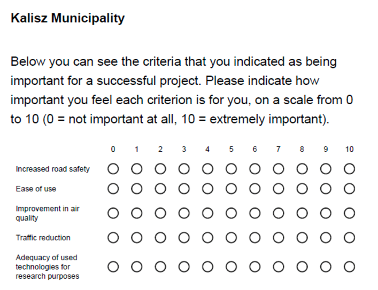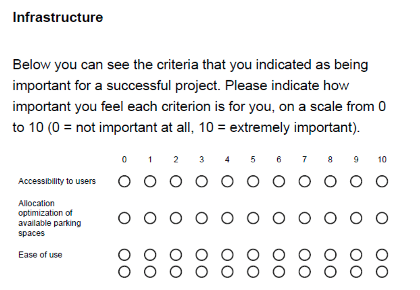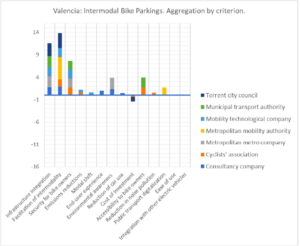Description
The third phase, or “analysis phase”, aims at developing a prioritised list of policy responses based on the financial, economic, and sustainability assessment and on stakeholders’ preferences. The alternative policy responses are prioritised using a Multi-Actor, Multi-Criteria Analysis (MAMCA). The process is facilitated using a Multi-Actor, Multi-Criteria Analysis Software.
A MAMCA is an appraisal method to compare policy alternatives along quantitative and qualitative criteria. Various local stakeholder groups determine the criteria and their relative importance. SPROUT used a modified MAMCA called Stakeholder-Based Impact Scoring (SIS). An SIS proceeds in seven steps (te Boveldt, 2019)
This step includes the specification of the problem that the pilot should respond to and derive policy alternatives that will be evaluated in later stages of the SIS. To perform an SIS, there should minimally be one baseline and one alternative to the baseline. The identification of policy responses is based on the SPROUT Policy Inventory.
Policy responses should consider:
- The adaptation of current policy elements / instruments
- The integration of urban mobility policies with other policies such as urban planning, social policy, or energy policy
- Policies to help urban mobility innovators overcome regulatory obstacles
Policies that gain the highest degree of consensus in the subsequent steps will be selected and further considered.
Example: Budapest Use Case 2:
| Problems encountered | High car traffic volume in the pilot area, there is not enough place for pedestrians and micromobility users. |
| Shared micromobility devices are denied at the pilot area because there is currently no regulation for their storage. | |
| Possible solutions | Create city specific planning regulations, that contains regulation to plan place for all modes of mobility |
| Create an additional regulation for micromobility in the topic of public place reorganization from the road operator and owner side. The pilot thinks that it can be a capital decree in the future. |
In this step, relevant stakeholders for conducting the pilot are identified. The stakeholders to involve are the representatives of groups that are impacted, or can impact, the pilot project (see step 2 under Co-creating and utilizing scenarios). An indicative list of stakeholders which can be used as starting point can be found in the SPROUT stakeholders inventory .
For the SIS process it is crucial that stakeholder groups have an understanding of their objectives (i.e. what they find important), such as reducing transport-related air pollution, reducing the number of accidents, or barrier-free public transport. A clear statement of objectives is required. Stakeholder groups can have several objectives.
The key task for stakeholders in this step is to derive criteria for the following question: what distinguishes a good project alternative from a bad one?
Criteria are linked to objectives. They are those aspects that stakeholders find most important when assessing the impact of a pilot project and/or a policy intervention. Different stakeholder groups find different criteria most important. Criteria can be both positive and negative. Examples include traffic safety, cost, or accessibility.
Within SPROUT, the alternatives that stakeholders were asked to reflect upon were the pilot situation without policy interventions versus the pilot situation with the proposed policy alternatives.
Due to the Covid pandemic, which restricted face-to-face workshops, stakeholders were asked to provide their criteria via email. The request letter provided a short description of the pilot without policy changes, and a short description of the pilot including the policy alternatives. The stakeholders were asked to come up with two to six criteria that would make the implementation of the pilot situation in combination with policy interventions successful, in their eyes.
An overview of the criteria per stakeholder group for Budapest can be found in the table below.
Example: Budapest use case 2: criteria per stakeholder group.
| Public transport operator | Mobility operators | |
| Economic sustainability of operations | Increased support for shared mobility | |
| Social sustainability of operations | Economic sustainability of operations | |
| Environmental sustainability of operations | Social sustainability of operations | |
| Increase in MaaS use | Environmental sustainability of operations | |
| Decrease of the environmental impact of transport | Decrease of the environmental impact of transport | Users of micromobility services |
| Decrease in private car use | Increased share of eco-friendly transport modes | Reliability of the service |
| Infrastructure operators | Walking or cycling associations | Decrease in traffic |
| Economic sustainability of operations | Coherence of the public space configuration | Coherence of the public space configuration |
| Environmental sustainability of operations | Increase in safe infrastructure for micromobility users | |
| Coherence of the public space configuration | Increase in modal shift | |
| Increase in road safety | Decrease of the environmental impact of transport | |
| Simplification of maintenance work |
The next step of the SIS is an evaluation of the impacts of alternative policy interventions (from Step 1) on these criteria. In SPROUT, the assessment was carries out by research partners in the project.
In this step, the effects of the pilot with policy implementation are compared to the pilot without policy changes for each of the criteria. The alternative is given a performance score on a 7-point scale, ranging from ‘Very negative’ to ‘Very positive’.
The key question to answer in this step is the following: in terms of each criterion, what would be the impacts (direction and magnitude) if the pilot was implemented in combination with the policy alternative, compared to the pilot implementation without the policy alternative?
The table below shows the results of an expert evaluation for the Valencia use case intermodal bike parkings (excerpt).
This step contains the attribution of weights by the stakeholders to ‘their’ criteria. To evaluate the relative weightings, stakeholders were asked to rate the importance of each criterion they suggested in Step 3 on a scale from 0 to 10.
An example of the Kalisz use case can be found below:


This step consists of aggregating the contribution of each identified policy alternative to the criteria across all stakeholders. Concretely, every identified policy alternative is evaluated on the different criteria by the use of the indicators and the measurement methods, and this is done for each stakeholder. This is done by multiplying the weight of a criterion, as attributed in step 5, with the impact, as assessed in step 4. This impact score will be either positive or negative, and will fall between +1 and -1.
The following example shows the results for SPROUT’s Valencia Pilot: intermodal bike parkings:
Box: Results for SPROUT Pilot: Intermodal bike parkings in Valencia:
While the current situation (Smart bike parkings at selected metro stations) is taken as a baseline, the pilot involves the development of additional infrastructure: the bike parkings will be well connected to the bike lane network and the authority responsible for the infrastructure will be different from the public company managing the metro stations and installing the parking.
As can be seen in the figure below, facilitation of intermodality, infrastructure integration and security for bike owners are by far the most important potential positive impacts, as these impacts are deemed important by most stakeholders, followed by the criteria ‘increase in environmental awareness’ and ‘accessibility to bike owners’. ‘Cost of investment’ is the only negative impact, but its effect is expected to be relatively minor.
This step consists of the ranking of the identified policy alternatives, with each alternative’s weak and strong points. This classification of the alternatives is done by the MAMCA software. This helps decision-makers by providing a comparison of the various alternatives. The last step of the MAMCA is a consensus-making step, where stakeholders involved find a compromise so that the decision-maker can then select the policy option that resulted as being most favourable. The idea behind this step is to find the best policy alternative based on the synergies and conflicts that were identified.
Policy responses that were selected in the different pilot cases are specified in the section “Respond”
SPROUT materials and tools
Impact assessment and city-specific policy response/Tel-Aviv pilot
Impact assessment and city-specific policy response/Budapest pilot
Impact assessment and city-specific policy response/Kalisz pilot
Impact assessment and city-specific policy response/Padua pilot
Impact assessment and city-specific policy response/Valencia pilot
Related tools and methods
Data required
Data is mainly collected during stakeholder engagement processes.
Further Information
This chapter is an adaptation of the SPROUT Deliverable D4.1: Pilot evaluation framework, authored by Beatriz Royo (ZLC) et al.; and on the Impact assessment and city-specific policy response reports for SPROUT cities



